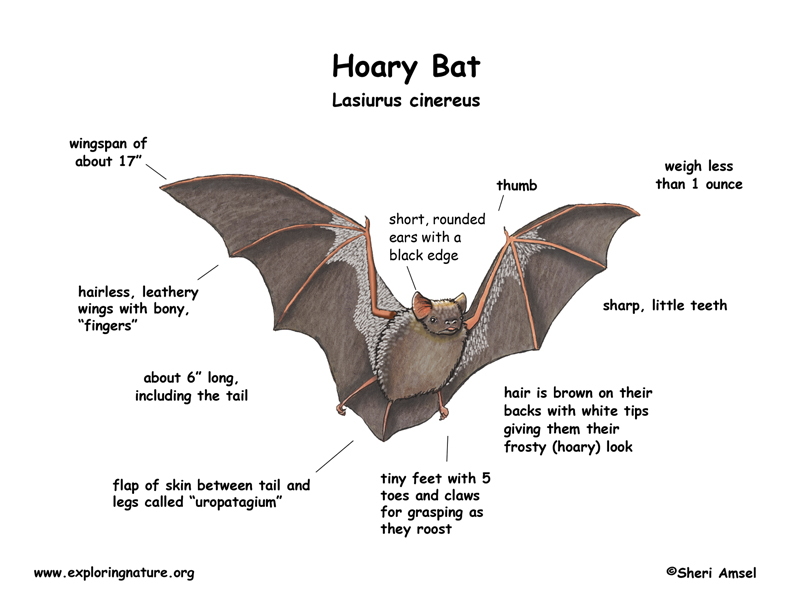

They are found in Southern Canada down through South America. In the U.S. they are the bat with the largest range, but are more common in the western states and not at all in Alaska. They are the only species of bat in Hawaii.
They live almost anywhere there are trees, but are more common in forest edges, where there is open land nearby to hunt for insects at night. They can be found in urban areas in parks and neighborhoods – wherever there are bugs to eat!
They are about 6” long, including their tail, with a wingspan of about 17”, but often weigh less than and ounce. Their hair is brown on their backs with white tips giving them their frosty (hoary) look. Their hair is uniformly brown underneath. They have short, rounded ears with a black edge. There is a flap of skin that stretched between the legs and tail called the uropatagium.
They migrate south in the colder months or hibernate until bugs hatch our in the spring. They are mostly found alone, but can be seen migrating in groups. They are nocturnal, coming out at night to hunt by echolocation along lake shores and in open fields. Echolocation is a kind of radar that uses the bat’s high-pitched calls to bounce off objects. They can actually “see” what is around them by how their calls bounce off their surroundings.
They eat insects – mostly moths and some beetles, grasshoppers, termites and even dragonflies.
They are killed by some birds of prey, including owls and hawks. Like all bats some fall prey to flying into fencing.
They mate in the fall, but females store the sperm until spring when they become pregnant. Like most bats, they give birth while hanging upside down in their roost. They can have up to 4 young, but average 2. They cling to their mothers to roost and feed during the day and rest alone hidden in the leaves at night while she hunts. They begin to fly in just over a month.
They can live up to 5 years in the wild. They are not a threatened species.
Related Resources:
High Resolution Diagram
Kingdom: Animalia
Phylum: Chordata
Subphylum: Vertebrata
Class: Mammalia
Order: Chiroptera
Family: Vespertilionidae
Subfamily: Vespertilioninae
Genus: Lasiurus
Species: Lasiurus cinereus
When you research information you must cite the reference. Citing for websites is different from citing from books, magazines and periodicals. The style of citing shown here is from the MLA Style Citations (Modern Language Association).
When citing a WEBSITE the general format is as follows.
Author Last Name, First Name(s). "Title: Subtitle of Part of Web Page, if appropriate." Title: Subtitle: Section of Page if appropriate. Sponsoring/Publishing Agency, If Given. Additional significant descriptive information. Date of Electronic Publication or other Date, such as Last Updated. Day Month Year of access < URL >.
Amsel, Sheri. "Bat (Hoary)" Exploring Nature Educational Resource ©2005-2024. December 14, 2024
< http://www.exploringnature.org/db/view/hoary-bat >

